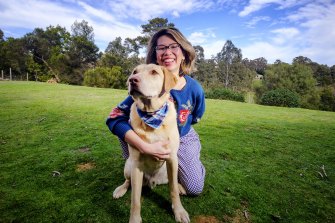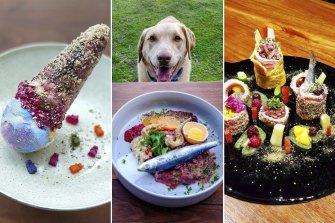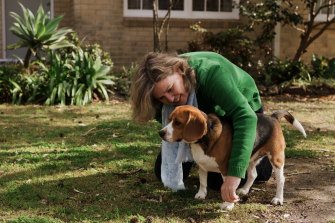Raw diet… for your dog? The new world of dog food

From brothy bowls of noodle soup to platters of sushi, Bowie’s meals look like they’d be right at home on MasterChef.
The five-year-old Labrador retriever’s diet is fancier than that of many humans, but he didn’t always eat this way. Owner Riesa Renata, from Hurstbridge, just outside of Melbourne, started him on kibble as a puppy, but after cycling through a few brands to try to fix his digestive issues, she transitioned him to a raw diet in 2018.
Riesa Renata and Bowie, of Instagram account @masterbowie2016, at their home in Hurstbridge.Credit:Luis Enrique Ascui
Renata, 36, says learning about all the needed nutrients and supplements was “a bit daunting” at first, but she saw improvements to Bowie’s health and coat. She’s since kept it up, with the support of her vet.
Bowie’s meat haul now takes up two-thirds of the freezer, while he and Renata share ingredients like fresh fruit and vegetables. She began posting photos on Instagram of Bowie’s food during the pandemic – “I love cooking … [and] he’s my only customer since the lockdown” – and her one big rule is variety.
“Imagine eating the same thing every day,” Renata says. “I don’t preach that everyone should do raw and fresh feeding, because every dog is different. Some dogs are better with raw, some are OK with kibble, I think you just have to be open-minded.”
Raw feeding is booming in the dog world. One Australian Facebook group has drawn almost 60,000 members since being created three years ago.
Riesa Renata posts Bowie’s fancy meals on Instagram account @masterbowie2016. Pictured from left: dog-friendly ice-cream, surf-and-turf, and sushi-like degustationCredit:Riesa Renata/Luis Enrique Ascui
It’s part of a wider trend in which pet food is intersecting with wellness, borrowing the glossy style and language you might associate with human clean eating ventures: whole natural ingredients, no hidden nasties and a pledge to fix an apparently broken industry.
From luxury pet grocers to personalised meal plans, scores of new businesses are catering to pets’ upgraded status as “fur babies”, as Australians spend $4 billion a year on pet food.
Three-year-old Sydney-based company Lyka, which sells fresh human-grade dog food, last month attracted $6.5 million in investment, while sleek kibble start-up Scratch, from Melbourne, shot to fame with the star power of surfer Mick Fanning.
Sydney-based dog trainer Barbara Hodel has seen how confused new owners are by the plethora of options, all purporting to be the best.
“They get completely lost because they don’t know what to choose,” Hodel says. “I think it has gotten out of hand.
“[Business owners] are realising it’s a big market and that pet owners are willing to spend money, and lots of it.”
Fiona Blackett, 53, adopted one-year-old beagle Charlie in August last year – her first dog in more than two decades, and she says the food options are “overwhelming”.
“[Back then] your choice was Pal, Pal and Pal. That was it,” Blackett says. “Now, you scroll and there are hundreds of different types, then you start thinking, ‘why don’t I just buy the stuff in the supermarket, what’s the difference?’”
Fiona Blackett’s Charlie is “treated like a little human”. Credit:James Brickwood
Blackett, from Sydney’s Northern Beaches, has tested several fresh and dry diets on Charlie, including a “hellishly expensive” brand that she says cost more than her own food. She’s found that high-quality kibble – usually topped with meat from the barbecue – suits him best, but she still second guesses herself when she reads chatter online.
“Sometimes you think, ‘I don’t know if I’m giving the right food’. There should be a manual for dog food.”
Melbourne vet Dr Linda Fleeman, a spokeswoman for the Australian Veterinary Association, says that as the pet food industry continues to expand, it’s crucial that the federal government establishes mandatory regulation to manage manufacturing practices, marketing claims and recalls, as was recommended by a 2018 Senate inquiry. Currently, adhering to nutrition and safety standards is voluntary.
“[It] makes it very difficult for pet owners and their vets to compare all the products,” Fleeman says.
“Our pets are considered family members. Therefore the community expectation is that pet foods are regulated in the same way as human foods.”
Fleeman says the case in July in Victoria, in which 23 dogs died and 67 were injured after eating contaminated raw meat, highlights the need for regulation.
Associate Professor David Thomas, a pet nutrition researcher at New Zealand’s Massey University, says the way our pets eat is changing with society’s fixation on personal wellbeing and the humanisation of our animals. “You’re not pet owners, you’re pet parents now,” Thomas says.
One 2019 study of almost 2200 pet owners found that more than half rated the importance of buying healthy food for their pet as equal to for themselves, while two-in-five said it was more important.
“Pet owners may get caught up in food trends instead of focusing on feeding their pets a nutritionally balanced, high quality, nutritious diet,” the researchers warned.
Thomas is critical of industry “jargon”, such as “grain-free”, which he says is nutritionally unnecessary. Research has also shown that dogs have genetically evolved to be able to thrive on a diet rich in starch.
While supportive of caring more about pet wellbeing, Thomas worries that owners are going too far by feeding human-grade food. There are about nine million pet dogs and cats in Australia, and they willingly eat nutritious parts of animals killed for human consumption that might otherwise go to waste, like organs, scraps and ground-up bone.
“The pet food industry should be complementary to the human food industry,” Thomas says. “We’re struggling to feed the planet as it is.
“There needs to be a realisation that nutrition for pets is well established … It’s not the same as human food.”
His big message is that no matter whether you choose to feed raw, dry or canned, there is no one single good diet out there.
“It’s become really divisive. [But] it’s personal choice over the type of format you use,” he says.
Tips on choosing what to feed your pet
- If using commercial diets, discuss with your vet and check if the supplier is compliant with the voluntary Australian Standard or international equivalent, AAFCO or FEDIAF
- If preparing home diets, do so in consultation with your veterinarian and a veterinary nutrition service such as the Veterinary Nutrition Group to avoid deficiencies
- Unless there are reasons for a consistent diet, such as diabetes or gastrointestinal sensitivity, it is worth ensuring a pet gets a mix of foods so that it is not exposed to a single pet food brand, to reduce the risk of toxicity
- Expensive is not necessarily better
- If a claim regarding a pet food seems too good to be true, then it probably is
Source: Dr Linda Fleeman, founder of Animal Diabetes Australia
What’s important is the underlying nutrition, Thomas says, and the key is to purchase food that is labelled as “complete and balanced” and adheres to the voluntary Australian standards or equivalent Association of American Feed Control Officials (AAFCO) guidelines. This applies for cat and dog food.
As unappetising as kibble may look to people, Thomas says it’s an effective way to ensure a pet has a diet that’s consistently healthy and balanced with every mouthful – as long as owners don’t overfeed. And because it’s cooked at high temperatures, pathogens are killed off.
“We know that it works, it’s kept pets alive and healthy for decades,” Thomas says.
As for home-prepared raw or cooked meals, which Sydney-based veterinarian Dr Leigh Davidson says have become a “status symbol”, they can be just as healthy, but she recommends consulting a qualified vet nutritionist. Davidson, director of service Your Vet Online, says it takes effort to meet all of an animal’s nutritional needs, including essential minerals, vitamins and fats.
“Unless you can afford it, have the time, and the space, then you might be better off buying a commercially prepared product.”
Davidson adds that she is wary of businesses that employ fear-mongering and guilt tactics in their marketing, particularly targeting kibble, and she recommends pet owners speak to their vet for advice.
“I’m not hard-nosed about whether you feed raw or kibble,” she says, but recommends owners choose a diet that has been developed with feeding trials and the company employs a degree-qualified nutritionist.
Make the most of your health, relationships, fitness and nutrition with our Live Well newsletter. Get it in your inbox every Monday.
Most Viewed in Lifestyle
From our partners
Source: Read Full Article


